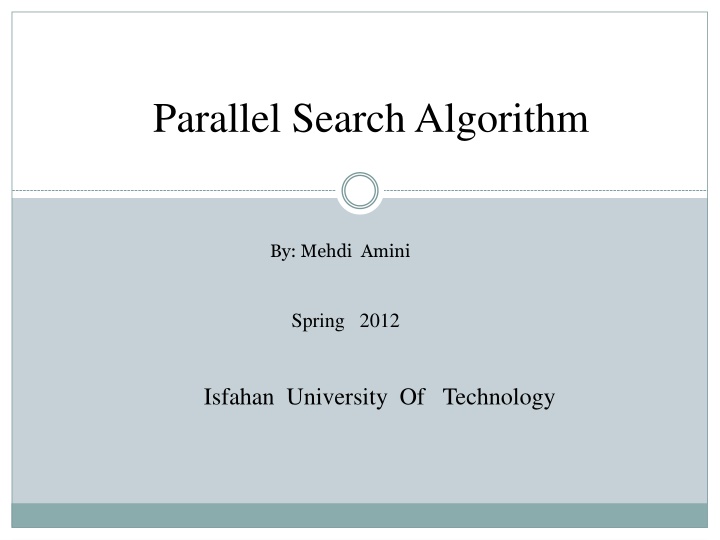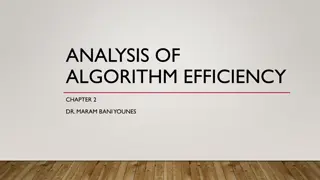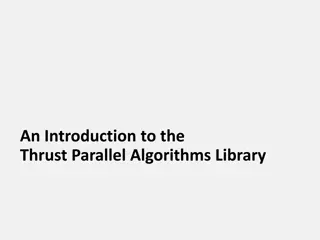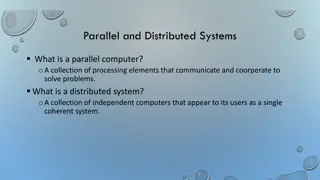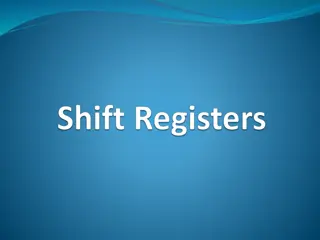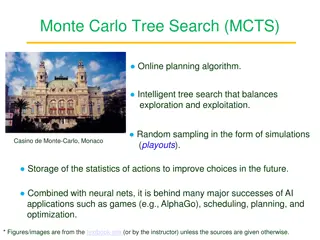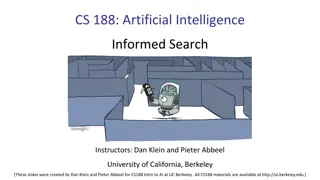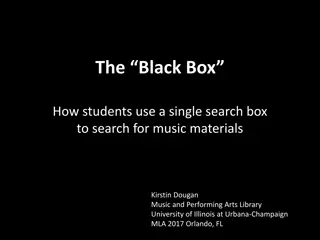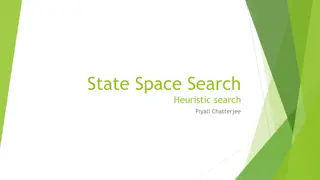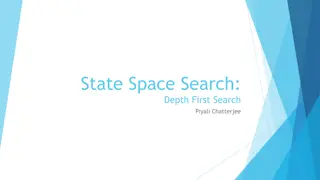Parallel Search Algorithm - Types and Approaches
Exploring parallel search algorithms in artificial intelligence, this study delves into various types like Sequential Depth First Search, Sequential Best First Search, and their parallel counterparts. The research outlines the process of searching for elements in initial and goal states, emphasizing informed and uninformed approaches. Discover the significance of knowledge in search algorithms and the methods used in finding the largest, smallest, and special keys in arrays or binary searches.
Download Presentation

Please find below an Image/Link to download the presentation.
The content on the website is provided AS IS for your information and personal use only. It may not be sold, licensed, or shared on other websites without obtaining consent from the author.If you encounter any issues during the download, it is possible that the publisher has removed the file from their server.
You are allowed to download the files provided on this website for personal or commercial use, subject to the condition that they are used lawfully. All files are the property of their respective owners.
The content on the website is provided AS IS for your information and personal use only. It may not be sold, licensed, or shared on other websites without obtaining consent from the author.
E N D
Presentation Transcript
Parallel Search Algorithm By: Mehdi Amini Spring 2012 Isfahan University Of Technology
OutLine: Type Of Search Algorithms Searching in Artificial Intelligence Sequential Depth First Search Sequential Best First Search Parallel Depth First Search Parallel Best First Search Another Parallel Searches Conclusion
Type Of Search Algorithm: We want to Find element
Type Of Search Algorithm: Initial state 8 1 7 6 5 3 2 4 Goal state 1 2 3 4 5 6 7 8
Type Of Search Algorithm: Find the Largest key Or Smallest key in the array 20 2 13 12 10 9 8 7 3 4 Find the Special key in an Ordered Array or Binary Search 1 2 8 10 12 13 18 27 30 40
Searching in Artificial Intelligence: There are Some Agents in AI for solving problems We don t have any knowledge about problem so we called this un-informed approach We have some knowledge about problem so we called this Informed approach
Un-Informed Approach: Depth First Search Bread First Search What is Depth First Search?
Sequential Depth first Search: Check each node ,Is it a goal node? if not expand it
Sequential Best First Search: In This approach Of search we have some knowledge about problem In this Approach we want to find optimum Solution What does knowledge mean?
Sequential Best First Search: Check each node ,Is it a goal node? if not expand it In this approach which node should be expanded? 80 90 100
Sequential Best First Search: Our algorithm to solve the problem optimally is A* In problem that we want to find a path between two point the knowledge is :f(n)=g(n)+h(n) g(n):real cost of path between initial node to n h(n):estimation of smallest path between n and goal node
Sequential Best First Search: 366=0+366 Arad Zerind sibiu Timisoara 449=75+374 447=118+329 393=140+253 Arad Riminicun Oradea Fagaras 646=280+366 671=291+380 413=220+193 415=239+176
Parallel Depth First Search: The critical issue in parallel depth-first search algorithms is the distribution of the search space among the processors
Parallel Depth First Search:: Important Parameters of Parallel DFS Load -Balancing Schemas: Asynchronous Round Robin Global Round Robin Random Polling
Parallel Best first Search: This algorithm contains two main components: Open list , Close list In most parallel formulations of BFS, different processors concurrently expand different nodes from the open list
Parallel Best first Search: There are two problems with this approach The termination criterion of sequential BFS fails for parallel BFS Since the open list is accessed for each node expansion, it must be easily accessible to all processors, which can severely limit performance
Parallel Best first Search: A general schematic for parallel best-first search using a centralized strategy Lock the list p3 Lock the list Lock the list Unlock the list p1 Unlock the list p2 Unlock the list
Parallel Best first Search: One way to avoid the contention due to a centralized open list is to let each processor have a local open list. The processors must communicate among themselves to minimize unnecessary search
Parallel Best first Search: Communication Strategies for Parallel Best-First Tree Search random communication strategy ring communication strategy blackboard communication strategy
Parallel Binary Search Algorithm: We have an ordered array ,we have two processors We part our array to P+1 parts , where p is number of processors 1 2 8 10 12 13 18 27 30 p1 p2
References: Introduction to parallel computings,addison wesley,second edition Akihiro kishimato; alex fukunaga; adi botea; Sclable,parallel best first search for optimal sequential planning Artificial interlligence:A modern approach , Russell and Peter Norvig,third edition An introduction to Parallel algorithm,Joseph jaja
